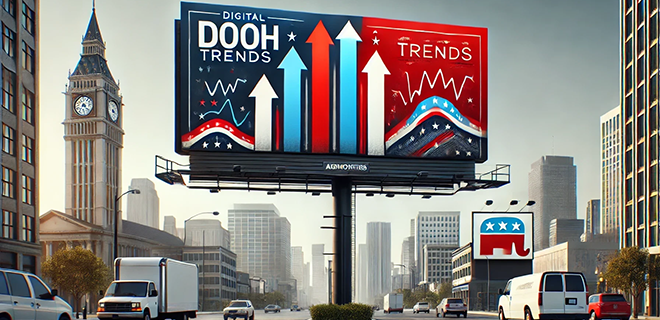
As political ad spend surges in OOH, publishers seize the opportunity to capture voter attention. Discover how creative campaigns, programmatic, and location-based targeting drive the future of political messaging in OOH and DOOH formats.
Out-of-home (OOH) and digital out-of-home (DOOH) advertising are gaining momentum, especially as part of omnichannel marketing strategies.
According to the IAB, 89% of ad sellers — including publishers and platforms — have expanded their political ad inventory since the last presidential election. Meanwhile, 86% of these sellers have seen a significant rise in demand. With political ad rates climbing for 84% of sellers, publishers are seizing the opportunity to leverage OOH advertising, targeting voters in high-traffic, real-world locations.
Since Kamala Harris entered the race, 91% of ad sellers have reported a surge in demand for national political ads, while 75% have seen growth locally. Political advertisers now leverage custom audience segments at unprecedented levels, using political affiliation, interest-based targeting, and demographic data like race and ethnicity. The creative potential and precise targeting offered by OOH advertising allow campaigns to connect with younger, multicultural voters in impactful ways.
It’s no secret that political campaigns now leverage the creative power of DOOH and OOH to drive awareness and action. Still, the real question is — how can publishers and advertisers fine-tune their offerings to capture this growing market?
In this Q&A with Anna Bager, President and CEO of The Out of Home Advertising Association of America (OAAA), we explore how OOH political ad spend is increasing, its growing effectiveness, and how publishers can capitalize on this market. We’ll dive into creative strategies, measurement challenges, and the rising role of location-based targeting, all shaping the future of OOH advertising for political campaigns.
She shares a ton of tips and strategies for publishers and advertisers alike. Check out the full convo below.
Surge in Political Ad Spend: Opportunities and Strategies
Yakira Young: What factors are driving the surge in political ad spend for OOH, and how can publishers adapt their offerings to capture this market?
 Anna Bager: The surge in political ad spend on OOH is part of a broader trend, with out-of-home advertising experiencing record-breaking growth in the first half of 2024. OOH produced a 3.4% increase in ad revenue in the second quarter, reaching $2.78 billion. Political advertisers are tapping into this momentum, recognizing OOH’s ability to engage voters in a meaningful way.
Anna Bager: The surge in political ad spend on OOH is part of a broader trend, with out-of-home advertising experiencing record-breaking growth in the first half of 2024. OOH produced a 3.4% increase in ad revenue in the second quarter, reaching $2.78 billion. Political advertisers are tapping into this momentum, recognizing OOH’s ability to engage voters in a meaningful way.
In fact, 68% of likely voters have seen political ads through OOH formats, with nearly half of them finding these ads personally influential. For publishers, this growing market presents an opportunity to adapt offerings that emphasize OOH’s high trust factor and visibility. Multicultural and younger voters, critical for this year’s election cycles, are key audiences that OOH tends to over-index with.
Lessons from Top OOH Advertisers
YY: What lessons can publishers learn from the top OOH brand spenders like Hotels.com and Apple in terms of effective advertising strategies?
AB: Top OOH spenders like Hotels.com, Apple, and other industry leaders are driving growth by capitalizing on high-visibility placements that resonate with diverse audiences. These brands blend location-based targeting with creative consistency, ensuring their messages reach the right consumers at key moments. For publishers, mirroring this success means enhancing cross-channel campaigns—incorporating DOOH screens or leveraging digital platforms for location-based targeting alongside traditional OOH placements.
The Rise of Transit Advertising
YY: How are transit ads achieving such significant growth, and can publishers replicate this success in other advertising formats?
AB: Transit advertising continues to lead growth, thanks to the captive environments offered by high-dwell locations like airports, subways, buses, and transit stations. These spaces generate strong consumer interaction, particularly through tap or scan technologies. Transit’s rise highlights the value of reaching audiences during their daily commutes. For publishers, replicating this success means employing dynamic placements like geo-targeted mobile ads and DOOH screens in public spaces to create highly relevant, engaging campaigns.
Location-Based Targeting and Audience Appeal
Yakira Young: What role does location-based targeting play in OOH’s success, and how can publishers incorporate similar strategies in their digital offerings?
Anna Bager: Location-based targeting is a core driver of OOH’s success, allowing campaigns to deploy with pinpoint accuracy. The growth of DOOH, now accounting for 33.4% of total OOH revenue, is a testament to the power of digital targeting. Publishers can take cues from this, incorporating geo-fencing and real-time ad optimization to meet the rising demand for hyper-local, personalized campaigns.
YY: How is OOH resonating with younger and multicultural audiences, and what insights can publishers gain from this trend?
AB: OOH’s appeal to younger and multicultural audiences is a major factor behind its growth. Gen Z and Millennials, in particular, appreciate the non-intrusive, visually engaging nature of OOH ads. Our research shows these demographics respond well to OOH’s clarity and shareability. Publishers can learn from this by creating short-form, engaging content that seamlessly integrates into the daily lives of mobile-first audiences.
Capitalizing on Economic Growth
YY: With economic indicators showing strength across various industries, how can publishers tailor their advertising solutions to capitalize on this growth?
AB: With the economy on the rise, advertisers are eager to engage consumers with increased spending power. OOH, especially in urban markets, is well-positioned to capture affluent audiences through premium placements. Financial services, technology, and retail sectors are already leading this charge. Publishers can capitalize by offering premium ad packages that combine OOH with targeted digital campaigns, helping brands reach high-intent consumers through multi-channel strategies.
Measuring Campaign Effectiveness
YY: How are OOH advertisers measuring the effectiveness of their campaigns, and what metrics are most valuable to them?
AB: OOH advertisers are now focused on measurable outcomes such as social media sharing, foot traffic, coupon redemptions, brand lift, and consumer engagement. This shift towards data-driven approaches is fueled by digital integrations, making campaign performance more transparent. For publishers, providing clear reporting and real-time analytics will be essential to meeting advertisers’ expectations and proving ROI across both OOH and digital formats.
Creative Campaigns and Cross-Channel Synergy
YY: What strategies are OOH advertisers using to create memorable and impactful campaigns, and how can these be applied to digital publishing?
AB: OOH is unique in its ability to deliver high-impact, memorable campaigns through bold creative that taps into emotions like humor or curiosity. DOOH adds flexibility, enabling brands to update messages in real time based on various inputs. For publishers, applying similar strategies in digital formats—focusing on visual storytelling and concise messaging—will ensure consistency and resonance across channels.
OOH’s Impact on Ad Budgets
YY: How is the increasing popularity of OOH affecting overall advertising budgets, and what implications does this have for digital publishers?
AB: OOH is often considered the last true mass-reach medium, offering access to consumers without the fear of ad-blocking or skipping. As OOH’s influence grows, some advertisers are shifting budgets from traditional digital formats to focus on high-impact placements. However, the potential for cross-channel synergy remains strong. DOOH can amplify the effectiveness of CTV campaigns, reinforcing messages without the risk of overexposure. For publishers, the key lies in positioning themselves as essential partners in omnichannel campaigns, where OOH and digital work together to maximize reach and impact.